Lancia Thema
The Lancia Thema (Type 834) is an executive car produced by the Italian automaker Lancia between 1984 and 1994, and one of four cars to share the Type Four platform alongside the Alfa Romeo 164, Fiat Croma and Saab 9000. The Thema was first shown in Turin Motor Show in 1984.
| Lancia Thema | |
|---|---|
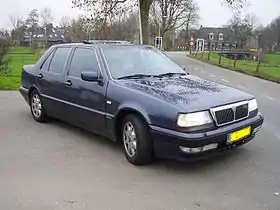 A third series Lancia Thema 3.0 V6 LS | |
| Overview | |
| Manufacturer | Lancia |
| Production | 1984 – 1994 |
| Assembly | Mirafiori plant, Turin, Italy Borgo San Paolo plant, Turin, Italy Grugliasco, Turin, Italy (Pininfarina) |
| Designer | Giorgetto Giugiaro at Italdesign (saloon) Pininfarina (station wagon) |
| Body and chassis | |
| Class | Executive car (E) |
| Body style | 4-door saloon 5-door station wagon |
| Layout | FF layout |
| Platform | Fiat Type Four (Tipo Quattro) platform[1] |
| Related | |
| Powertrain | |
| Engine |
|
| Transmission | 5-speed manual 4-speed automatic[2] |
| Dimensions | |
| Wheelbase | 2,660 mm (104.7 in) |
| Length | 4,590 mm (180.7 in) |
| Width | 1,755 mm (69.1 in) |
| Height | 1,440 mm (56.7 in) |
| Kerb weight | 1,150–1,300 kg (2,535.3–2,866.0 lb) |
| Chronology | |
| Predecessor | Lancia Gamma Lancia Trevi |
| Successor | Lancia Kappa |
In February 2011, it was reported that the second generation of the Chrysler 300C, due for launch later that year, would be marketed as Lancia Thema in all European markets, except the UK and Ireland, which would retain the 300C nameplate.[3][4]
First generation (1984 - 1994)
Overview
The Thema was Lancia's luxury car based on the all-new Type Four platform, the others being the Fiat Croma, the Saab 9000 and, later, the Alfa Romeo 164. The Thema was available as a saloon and as a station wagon designed and produced by Pininfarina.
.jpg.webp)
First series
The Lancia Thema was announced in May 1984,[5] then introduced to the motoring press with an event held in October 1984 in Vienna, and to the general public at the Turin Motor Show in November of the same year.[6] The first series Thema was built between 1984 and 1988, with four different models initially available. Two came with a twin cam 8-valve, fuel injected 1,995 cc 4-cylinder petrol engine, in naturally aspirated guise on the Thema i.e. or turbocharged and intercooled on the Thema i.e. turbo. Engine output was 120 PS and 165 PS respectively. The most expensive model was the Thema 6V, powered by a 150 PS, 2,849 cc V6, tuned for smoothness. On most European markets a 2,445 cc, 100 PS four-cylinder turbocharged and intercooled four-cylinder diesel engine was also available, on the Thema turbo ds. 1986 saw the introduction of the Pininfarina-designed Thema Station Wagon, available with the two turbocharged engines only,[7] and of the Ferrari V8-engined Thema 8·32.
Second series
The second series Thema was presented in the Paris Motor Show in September 1988.[8] New 16-valve 2.0-litre engines replaced the previous 8-valve units, increasing the power output to 147 PS (108 kW) on the naturally aspirated Thema i.e. 16v and to 185 PS (136 kW) on the Thema turbo 16v. The 8-valve 2-litre, now producing 117 PS (86 kW), remained on sale on the Thema i.e. base model. The 147 PS (108 kW) six-cylinder on the Thema V6 was only mildly revised. The diesel engine on the Thema turbo ds increased marginally in capacity, to 2,499 cc, and more significantly in output, to 118 PS (87 kW).[8]
A number of small visual updates were made to freshen the Thema's look. Upfront there was a more prominent grille with vertical instead of horizontal bars, and the turn indicators had been moved beneath the main headlamp units, under horizontal dark-tinted lenses. At the rear all model badging was removed, and the turn signals and backup lamp lenses were now tinted red. Finally the side rubbing strips, side skirts, wheel covers and 8-spoke alloy wheels were redesigned. The station wagon and the 8·32 received similar updates. With five engines available of the saloon, three on the SW (the two 16-valve petrols and the turbo diesel) and the 8·32, the Thema range consisted of nine different models. The different models received almost no visual distinctions, aside from the 8·32. Other models looked largely identical aside from badging, wheel dimensions, and wheel design (along with body-coloured mirror housings on top versions).[9] Additionally the 4- and 6-cylinder petrol engines were also produced in catalytic converter-equipped versions, with slightly reduced output, for sale on markets where such equipment was mandatory.
Third series
The series two was then replaced by the facelifted third and last series, introduced in the Paris Motor Show in September 1992 and produced from 1992-1994. Four trim levels—base, LE, LS and LX—were introduced across the range; the 2.9-litre V6 engine was replaced by a more powerful 175 PS 3.0-litre unit, sourced from Alfa Romeo.[10]
Production of the Thema ceased in 1994, when Lancia withdrew from RHD markets (including the United Kingdom) in response to falling sales and the Thema was replaced by the Lancia Kappa. A total of over 336,000 Thema saloons were produced.[11]
Variants
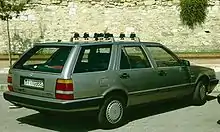
The station wagon
In addition to the saloon, a station wagon was jointly developed and produced by Lancia and Pininfarina in Grugliasco. It was shown in prototype form at the September 1985 Frankfurt Motor Show,[12] and in definitive form at the March 1986 Geneva Motor Show.[7] Zagato had also shown a station wagon proposal earlier, at the 1985 Geneva Motor Show. This prototype, which remained a design study, with a larger glass area in the rear and with more discreet D-pillars than for the Pininfarina variant.[13]
Pininfarina was also tasked with producing the new bodystyle. The Lancia factory assembled all the body-in-white parts shared with the saloon; the incomplete bodies were sent to Pininfarina, where they were completed and painted, and final assembly was carried out. The station wagon version was never offered in a right-hand drive variant. In total 21,074 Thema station wagons would be built by Pininfarina between 1986 and 1994 in their Borgo San Paolo plant.[14]
Thema 8·32
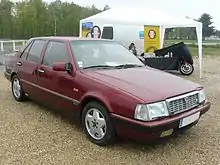
First shown at the Turin Auto Show in 1986, the Lancia Thema 8·32 ("8" standing for the number of cylinders and "32" for the number of valves) was assembled at Lancia's S. Paolo plant in Turin.[15] It used a 2,927 cc, Tipo F105L, Ferrari V8. This engine was based on the unit used in the Ferrari 308 and in the Ferrari Mondial Quattrovalvole, and some of the componentry was assembled by Ducati[16] from castings made at Maranello. The engine differed from other Ferrari V8s of the time in that it was equipped with a cross-plane type crankshaft rather than the usual flat-plane crankshaft, smaller valves and different firing order. All this to make the engine characteristics more suitable in a four-door luxury saloon. In non catalysed form the engine produced 215 PS (158 kW) at 6,750 rpm, and the car was capable of 0–100 km/h in 6.8 seconds and a top speed of 240 km/h (149 mph).[17] Catalysed versions were slightly detuned to 205 PS (151 kW) which gave 0–100 km/h in 7.2 seconds and a top speed of 235 km/h (146 mph). The transmission was a 5-speed manual gearbox; there was no automatic option. The braking system used larger 294 mm vented front discs and the standard 251 mm rear ones from the other Themas.
All 8·32s featured Bosch KE3 Jetronic fuel injection, ABS, ZF's brand new Servotronic electronically controlled rack-and-pinion power steering (which varied steering wheel effort according to vehicle speed), and a retractable rear spoiler.[18] The latter, designed to increase high speed stability, was controlled by the driver via a rotary switch on the right stalk. In closed position, it would fit flush with the boot lid. The tyres were specially developed 205/55 VR15 Goodyears on five-spoke 6J×15 alloy wheels.
The car offered a handmade wood-and-Alcantara (or optional Poltrona Frau leather) interior, and was complete with similar luxury equipment as LX versions of the Thema. Stitched leather covered the entire dashboard, the steering wheel (including centre), gear and handbrake levers and booths, centre console, door panels and sun visors, while the headlining was Alcantara. A bespoke dashboard fascia housed two main instruments, six small auxiliary gauges, and triple round air conditioning vents. Like the door cappings and the lids concealing the radio and ashtray, it was veneered in matte varnish burr wood. The instrumentation had black dials with yellow hands and markings; it included water thermometer, oil thermometer and pressure gauge, and check panels for the lights and the drivetrain. The seats (and matching door panel inserts) were trimmed in beige or date brown Alcantara as standard, with black or brown leather was an optional extra. Brown interiors got colour-matching switchgear, carpets and trim. Irrespective of interior selection, Thema 8·32 buyers could choose from five paint colours, all metallics: Blizzard Blue, Winner Red, Quartz Grey, Reflex Green and Black. A double hand-painted pinstripe (the upper matched to body colour, the lower yellow) ran along the sides and the rear of the car. Besides the paint scheme, retractable spoiler and wheels, the only exterior details setting the 8·32 apart from other Themas were yellow "8·32" badges, a silver eggcrate-type grille, and twin exhaust outlets. Some notable options were automatic climate control, electrically actuated sunroof, provision for a car phone in the front armrest, and rear individual power seats.[19]
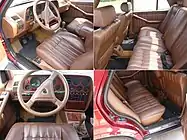 Poltrona Frau interior
Poltrona Frau interior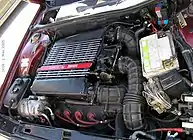 The 3-litre V8 was badged "Lancia by Ferrari".
The 3-litre V8 was badged "Lancia by Ferrari".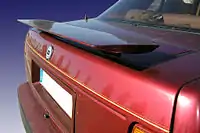 The rear spoiler retracted flush with the boot lid.
The rear spoiler retracted flush with the boot lid.
In 1988 the 8·32 received series 2 updates like other Themas, including new lights front and rear, a smaller grille badge, removal of model badging at the rear and on the side skirts, and the new side rubbing strips (previously absent on this model). There were no third series 8·32s. This version of the Thema was produced in limited numbers, with 2370 Series 1 built between 1986 and 1988 and 1601 Series 2 built between 1989 and 1992. All were left-hand drive, although one Thema 8·32 was converted to right hand drive by TAK Motor Co. in South Africa in 1987 for the MD of TAK.
The Thema 8·32's key competitors were some of the fastest saloon models of the late 1980s including the Audi 100 Quattro, BMW M535i, Ford Sierra RS Cosworth, Saab 9000 2.3 Turbo S, and the Vauxhall Lotus Carlton/Opel Lotus Omega.
Thema Limousine
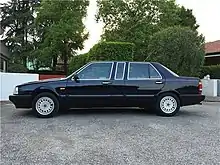
Built only on request by wealthy customers and Fiat-Group executives, the Lancia Thema Limousine featured the same interior as the LX and the 8.32 versions. Most of them were powered by a 2.8 L PRV V6 engine, replaced in the last ones by the 3.0 L Alfa Romeo V6 engine. Only 24 Thema Limousines were built.[20] The wheelbase of the car was extended by 30 cm (1 ft) to 2,960 mm (116.5 in), with a resulting overall length of 4,890 mm (192.5 in). The weight increased to 1,400 kg (3,090 lb), or by just over one fifth. The price, meanwhile, was up nearly sixty percent over a comparably equipped regular wheelbase Thema V6.[21]
Engines
With the exception of the 8.32 Ferrari engine, Thema powerplants originated from the Fiat engine series designed by Aurelio Lampredi, the famed engine designer formerly of Ferrari and Alfa Romeo. The straight-4 2.0 L petrol engine, available in both naturally aspirated and turbocharged versions, was refined and offered good performance. Earlier Themas were also offered with a 2.8 L PRV V6 engine, developed in cooperation with Peugeot, Renault, and Volvo. This unit was replaced in 1992 with a 3.0 L Alfa Romeo V6 engine (Fiat had bought Alfa Romeo in 1986 and gained access to this engine).
| Model | Displacement | Power | Torque | Top speed | 0–100 km/h,s (0-62 mph,s) |
Years | |
|---|---|---|---|---|---|---|---|
| saloon | station wagon | ||||||
| 2.0 8V | 1,995 cc (121.7 cu in) | 120 PS (88 kW; 118 hp) at 5250 rpm | 170 N⋅m (125 lb⋅ft) at 3300 rpm | 195 km/h (121 mph) | - | 9.7 | 1985–1989 |
| 2.0 8V | 1,995 cc (121.7 cu in) | 116 PS (85 kW; 114 hp) at 5600 rpm | 162 N⋅m (119 lb⋅ft) at 4000 rpm | 191 km/h (119 mph) | - | 10.4 | 1987–1989 |
| 2.0 8V | 1,995 cc (121.7 cu in) | 116 PS (85 kW; 114 hp) at 5600 rpm | 162 N⋅m (119 lb⋅ft) at 4000 rpm | 195 km/h (121 mph) | - | 11.4 | 1989–1995 |
| 2.0 16V | 1,995 cc (121.7 cu in) | 147 PS (108 kW; 145 hp) at 6000 rpm | 173 N⋅m (128 lb⋅ft) at 4000 rpm | 202 km/h (126 mph) | - | 10.4 | 1989–1992 |
| 2.0 16V | 1,995 cc (121.7 cu in) | 155 PS (114 kW; 153 hp) at 6500 rpm | 181 N⋅m (133 lb⋅ft) at 3500 rpm | 205 km/h (127 mph) | - | 10.1 | 1992–1995 |
| 2.0 Turbo 8V | 1,995 cc (121.7 cu in) | 165 PS (121 kW; 163 hp) at 5500 rpm | 290 N⋅m (214 lb⋅ft) at 2750 rpm | 218 km/h (135 mph) | 210 km/h (130 mph) | 7.2 | 1985–1988 |
| 2.0 Turbo 8V | 1,995 cc (121.7 cu in) | 150 PS (110 kW; 148 hp) at 5500 rpm | 245 N⋅m (181 lb⋅ft) at 2700 rpm | 210 km/h (130 mph) | - | 7.9 | 1988–1989 |
| 2.0 Turbo 16V | 1,995 cc (121.7 cu in) | 180 PS (132 kW; 178 hp) at 5500 rpm | 270 N⋅m (199 lb⋅ft) at 2500 rpm | 222 km/h (138 mph) | - | 8.0 | 1989–1992 |
| 2.0 Turbo 16V | 1,995 cc (121.7 cu in) | 205 PS (151 kW; 202 hp) at 5750 rpm | 304 N⋅m (224 lb⋅ft) at 3750 rpm | 230 km/h (143 mph) | - | 7.2 | 1992–1995 |
| 2.8 V6 12V | 2,849 cc (173.9 cu in) | 150 PS (110 kW; 148 hp) at 5250 rpm | 245 N⋅m (181 lb⋅ft) at 2700 rpm | 208 km/h (129 mph) | - | 8.2 | 1985–1989 |
| 2.8 V6 12V | 2,849 cc (173.9 cu in) | 150 PS (110 kW; 148 hp) at 5000 rpm | 225 N⋅m (166 lb⋅ft) at 3500 rpm | 205 km/h (127 mph) | - | 8.4 | 1989–1992 |
| 3.0 V6 12V | 2,959 cc (180.6 cu in) | 175 PS (129 kW; 173 hp) at 5500 rpm | 250 N⋅m (184 lb⋅ft) at 4500 rpm | 220 km/h (137 mph) | - | 8.1 | 1992–1995 |
| 2.9 V8 32V | 2,927 cc (178.6 cu in) | 215 PS (158 kW; 212 hp) at 6750 rpm | 285 N⋅m (210 lb⋅ft) at 4500 rpm | 240 km/h (149 mph) | - | 6.8 | 1987–1989 |
| 2.9 V8 32V | 2,927 cc (178.6 cu in) | 205 PS (151 kW; 202 hp) at 6750 rpm | 263 N⋅m (194 lb⋅ft) at 5000 rpm | 235 km/h (146 mph) | - | 7.2 | 1989–1992 |
| 2.5 TD | 2,445 cc (149.2 cu in) | 100 PS (74 kW; 99 hp) at 4100 rpm | 217 N⋅m (160 lb⋅ft) at 2300 rpm | 185 km/h (115 mph) | 180 km/h (112 mph) | 11.9 | 1985–1989 |
| 2.5 TD | 2,499 cc (152.5 cu in) | 118 PS (87 kW; 116 hp) at 3900 rpm | 245 N⋅m (181 lb⋅ft) at 2200 rpm | 195 km/h (121 mph) | - | 11.0 | 1989–1992 |
| 2.5 TD | 2,499 cc (152.5 cu in) | 118 PS (87 kW; 116 hp) at 4100 rpm | 245 N⋅m (181 lb⋅ft) at 2400 rpm | 195 km/h (121 mph) | - | 11.5 | 1992–1995 |
Second generation (2011 – 2014)
| Lancia Thema II | |
|---|---|
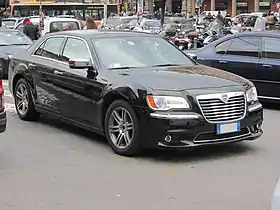 | |
| Overview | |
| Manufacturer | FCA |
| Also called | Chrysler 300 (North America) Chrysler 300C (UK & Ireland) |
| Production | 2011 - 2014 |
| Model years | 2011 – 2014 |
| Assembly | Brampton, Ontario, Canada (Brampton Assembly) |
| Body and chassis | |
| Body style | 4-door notchback sedan |
| Platform | Chrysler LD platform |
| Related | Dodge Charger Dodge Challenger |
| Powertrain | |
| Engine | 3.6 L Pentastar V6 3.0 L VM A630 turbodiesel V6 |
| Transmission | 5-speed 5G-Tronic automatic 8-speed 8HP45 automatic[22] |
| Dimensions | |
| Wheelbase | 120.2 in (3,053 mm) |
| Length | 198.6 in (5,044 mm) |
| Width | 75.1 in (1,908 mm) |
| Height | 58.4 in (1,483 mm) |
| Chronology | |
| Predecessor | Lancia Thesis |
Starting in the 2011 model year and ending in early 2014, the Chrysler 300C was sold in Europe's left hand drive markets as the Lancia Thema, and as a right hand drive Chrysler 300C in the United Kingdom and Ireland.[23] It was discontinued due to low sales.
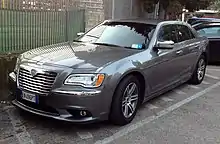 Lancia Thema.
Lancia Thema. Lancia Thema rear view.
Lancia Thema rear view.
Powertrain
| Lancia[24] - (Chrysler UK) | |||||
|---|---|---|---|---|---|
| Model | Engine | Displacement | Power at rpm | Torque at rpm | Years |
| Petrol | 3.6 V6 Pentastar | 3,604 cc (219.9 cu in) | 286 PS (210 kW; 282 hp) at 6,350 rpm | 340 N⋅m (251 lbf⋅ft) at 4,650 rpm | 2011–2014 |
| Diesel | 3.0 V6 VM Motori A630 | 2,987 cc (182.3 cu in) | 190 PS (140 kW; 187 hp) at 4,000 rpm | 440 N⋅m (325 lbf⋅ft) at 1,600–2,800 rpm | 2011–2014 |
| 239 PS (176 kW; 236 hp) at 4,000 rpm | 550 N⋅m (406 lbf⋅ft) at 1,800–2,800 rpm | ||||
References
- "Curiosidades Tipo". Fiat Tipo Portugal. Archived from the original on 5 March 2012. Retrieved 30 December 2013.
- "Lancia/Models/Lancia Thema". carsfromitaly.net. Retrieved 2007-08-03.
- "Archived copy". Archived from the original on 2013-04-11. Retrieved 2013-02-06.CS1 maint: archived copy as title (link)
- Autocar, Feb 5, 2011 Chrysler 300C review by Paul A Eisentein
- Fenu, Michele (24 May 1984). "Ecco la nuova Lancia "Thema" una berlina comoda e veloce" [Here's the new Lancia «Thema», a fast and comfortable saloon]. La Stampa (in Italian). p. 11. Retrieved 1 May 2019.
- Fenu, Michele (31 October 1984). ""Thema", una sfida per l'Europa" [«Thema», a European challenger]. La Stampa (in Italian). p. 9. Retrieved 1 May 2019.
- Fenu, Michele (4 July 1986). "Station wagon, largo alla Thema" [Station wagons, make room for the Thema]. La Stampa (in Italian). p. 15. Retrieved 2 May 2019.
- Fenu, Michele (22 September 1988). "La seconda sfida della Thema". La Stampa (in Italian). p. 10. Retrieved 30 April 2019.
- Mastrostefano, Raffaele, ed. (January 1989). "Prove su strada: Lancia Thema 16 Valvole" [Road test]. Quattroruote (in Italian). Vol. 34 no. 399. Milan, Italy: Editoriale Domus. p. 170.
- Fenu, Michele (12 September 1992). "Potenza morbida e un tocco di classe". La Stampa (in Italian). p. 35. Retrieved 30 April 2019.
- "PRODUKTIONSZAHLEN MARKE LANCIA BIS 2004" (PDF). lancia-historie.de.
- Fenu, Michele (13 September 1985). "Thema all'attacco tra le station-wagon" [The Thema takes on the station wagons]. La Stampa (in Italian). p. 15. Retrieved 2 May 2019.
- Bernardet, Alain (April 1985). "Salon de Genève" [The Geneva Show]. Echappement (in French). Paris, France: Michael Hommell (198): 44–45.
- "PRODUZIONE COMPLESSIVA" (PDF). pininfarina.it. Archived from the original (PDF) on 2011-06-05. Retrieved 2007-08-03.
- "Lancia Thema 832". Lancia Thema Garage. Archived from the original on 2008-02-15. Retrieved 2007-08-03.
- "Heritage Features and News". ducati.com. Retrieved 2007-08-03.
- Fenu, Michele (22 August 1986). "Quella "Thema" ha messo le ali". La Stampa (in Italian). p. 14. Retrieved 2 May 2019.
- Rogliatti, Gianni (28 November 1986). "I segreti tecnici della Thema Ferrari" [The technological secrets of the Thema Ferrari]. La Stampa (in Italian). p. 15. Retrieved 2 May 2019.
- "Lancia cerca il sorpasso". Quattroruote. December 1986.
- "Lancia Thema versioni speciali". lanciathema.it (in Italian). Lancia Thema Club Italia. Archived from the original on 4 October 2008. Retrieved 1 May 2019.
- Liberali, Sandro, ed. (1987-12-17). "Quanto costeranno le auto a gennaio: il listino di tutte le auto" [How much cars will cost after January: List of all cars]. Auto Oggi (in Italian). Verona, Italy: Arnoldo Mondadori. 2 (54): 28.
- "New Eight Speed Transmission Introduced by Chrysler". Retrieved 3 October 2020.
- "New Lancia Thema: Chrysler 300's European Alter Ego Officially Revealed". Carscoop. 14 February 2011. Archived from the original on 25 July 2011. Retrieved 3 December 2014.
- "New Thema: alternative class". lanciapress. 30 August 2011. Retrieved 3 December 2014.
| Wikimedia Commons has media related to Lancia Thema (1984). |